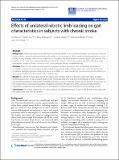Effects of unilateral robotic limb loading on gait characteristics in subjects with chronic stroke
Author(s)
Khanna, Ira; Roy, Anindo; Rodgers, Mary M.; Krebs, Hermano Igo; Macko, Richard M.; Forrester, Larry W.; ... Show more Show less
Download1743-0003-7-23.pdf (907.9Kb)
PUBLISHER_CC
Publisher with Creative Commons License
Creative Commons Attribution
Terms of use
Metadata
Show full item recordAbstract
Background Hemiparesis after stroke often leads to impaired ankle motor control that impacts gait function. In recent studies, robotic devices have been developed to address this impairment. While capable of imparting forces to assist during training and gait, these devices add mass to the paretic leg which might encumber patients' gait pattern. The purpose of this study was to assess the effects of the added mass of one of these robots, the MIT's Anklebot, while unpowered, on gait of chronic stroke survivors during overground and treadmill walking. Methods Nine chronic stroke survivors walked overground and on a treadmill with and without the anklebot mounted on the paretic leg. Gait parameters, interlimb symmetry, and joint kinematics were collected for the four conditions. Repeated-measures analysis of variance (ANOVA) tests were conducted to examine for possible differences across four conditions for the paretic and nonparetic leg. Results The added inertia and friction of the unpowered anklebot had no statistically significant effect on spatio-temporal parameters of gait, including paretic and nonparetic step time and stance percentage, in both overground and treadmill conditions. Noteworthy, interlimb symmetry as characterized by relative stance duration was greater on the treadmill than overground regardless of loading conditions. The presence of the unpowered robot loading reduced the nonparetic knee peak flexion on the treadmill and paretic peak dorsiflexion overground (p < 0.05). Conclusions Our results suggest that for these subjects the added inertia and friction of this backdriveable robot did not significantly alter their gait pattern.
Date issued
2010-05Department
Massachusetts Institute of Technology. Department of Mechanical EngineeringJournal
Journal of NeuroEngineering and Rehabilitation
Publisher
BioMed Central Ltd
Citation
Khanna, Ira et al. “Effects of unilateral robotic limb loading on gait characteristics in subjects with chronic stroke.” Journal of NeuroEngineering and Rehabilitation 7 (2010): 23.
Version: Final published version
ISSN
1743-0003